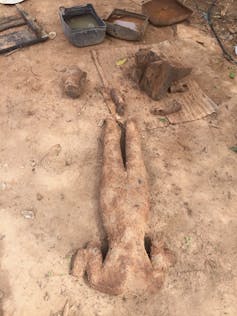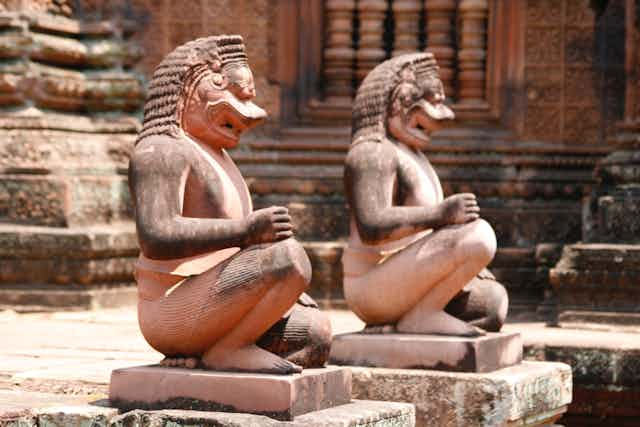As part of my work as an archaeologist, my team and I recently discovered an ancient artists’ studio in UNESCO-listed Angkor, an area in Cambodia that was home to numerous capitals of the Khmer Empire and is now one of the most important archaeological sites in Southeast Asia.
The finest examples of Cambodian art produced at these sites during the Angkorian period (circa 800-1400CE) are recognised as among the greatest artistic masterpieces of the pre-modern world.
Sadly, the looting of such material has caused considerable problems in a world that is progressively becoming concerned about the integrity of both public and private collections.
Since 2014, art institutions and private collectors have returned 11 sculptures to Cambodia. All were looted, or illegally obtained or exported.
This represents a significant post-colonial correction in the ownership of cultural property. But for about the same amount of time that looted art has been traded between buyers and sellers, another issue has remained hidden.

Fakes have overrun the Cambodian antiquity market, their authenticity obscured by the skill of the artists who make them. Indeed, a significant proportion of the artists are so accomplished that the modern origins of their work will probably never be recognised.
A homage to Angkorian sculpture
The art of Angkor and mainland Southeast Asia is particularly vulnerable. In correspondence with me, Helen Jessup, an eminent art historian and the author of six books on Cambodian art, made the connection between war, looting, and fakes:
Civil disturbances roiling Cambodia for 30 years made access difficult and led to a thinning of the ranks of experts in the field, including within Cambodia itself. Political uncertainty enabled illicit access to ancient sites and looting was rampant. Thailand was the usual destination for the stolen objects, handled by networks of middlemen and dealers and serving as models for skilled craftsmen to replicate. Provenance issues in strife-torn regions were fudged and acquisitions increased with few questions asked.
While peace has thankfully returned to Cambodia, the lucrative production of fakes continues.
Few know more about the production of replicas than contemporary artist Jim Sanborn, who witnessed the skill of Cambodian fakers first-hand while researching an art project of his own.
He told me:
Over a four-year period I travelled back and forth to infiltrate the forgery trade in order to gain the knowledge that generations of forgers had used to age their pieces.
The result was Sanborn’s path-breaking work Without Provenance: The Making of Contemporary Antiquity. It presents sandstone sculptures made in Cambodia and falsely aged in his US studio.
Jim Sanborn is a celebrated artist with pieces in collections worldwide, but he is still seeking an exhibitor for this challenging work that exposes the faking of Khmer art. The subversion of Without Provenance is testament to the unease with which custodians of Southeast Asian art approach authenticity and provenance.
Makers and models
In 2012, I accompanied Sanborn to a workshop in rural Cambodia. Posing as an art collector, I was offered contemporary replicas as genuine Angkorian sculptures. Objects like the ones we examined are sold at international auctions for anywhere between ten to one hundred times the sale price in rural Cambodia.

We were shown numerous sculptures in various stages of production. Even with an expert’s eye, often the only clue to the sculptures’ contemporaneity was the fact that we saw them in a workshop.
The art works were created using techniques not employed to produce art for the tourist market. Polishing obscures the giveaway marks that modern tungsten-tipped chisels leave behind, for instance.
At two or three months, the carving process is relatively quick compared to the task of artificial ageing, which can take many years.
Identifying a fake sculpture is not an easy task. Artists work within a family tradition, with knowledge passed from master to apprentice. Certain practices of cultural and artistic reproduction might well be unbroken since the time of Angkor.
Master craftsmen do not copy known sculptures, but design original works in the style of a particular time period. Variations in decoration, iconography and quality are commonly used to mimic actual antiquities.
To make matters more difficult, identifying a genuine sculpture is not very simple either. Even the most accomplished connoisseur will question authentic sculptures that intentionally reference iconography and motifs from earlier periods. For example, a group of sculptures produced in the ninth century have only recently been identified as 12th century copies.
When I asked Helen Jessup about identifying fakes and their proliferation, she said:
It will probably never be certain which of the pieces acquired from as early as the 1980s are real and which are fakes, but it is fair to ask why nobody wondered why, after almost a century of diligent research and acquisition by the French, so many, and so many perfect sculptures were appearing.
Revisiting authenticity

Technical analyses are the best tests. Regrettably, these are not foolproof either. Contemporary artists use the same sources of stone as the ancients; and fakers can replace clay cores of contemporary sculptures with ancient ones to avoid detection by scientific dating techniques.
Assistant Professor Christian Fischer from the UCLA/Getty Conservation Program is an expert in the types of stone used by ancient Cambodian artists.
Fischer told me about the extent to which fakers are one step ahead of would-be experts:
Fakers are aware of the published research that can help them to improve their artificial ageing procedures. For example, from the late 1990s, the appearance of questionable sculptures showing a surface layer enriched in manganese might be related to equivalent descriptions of manganese in the academic literature. This feature is absent on notorious fakes made in the 1970s and 1980s.
We continuously change the way objects of the past are appreciated and represented in terms of the present. Angkorian sculptures have always been treasured for their aesthetic beauty and as we learn more about them, we begin to recognise their significance to those who produced and venerated them, and especially their value to Cambodians today.
The ancient sculptures of Southeast Asia embody impressive examples of human creativeness and increase cross-cultural knowledge. But how might we accept replica sculptures acquired from a market full of objects with insufficient provenance?
Fearing the potential reputational damage that will follow if they’re known to have fallen prey to fakers’ deception, some custodians of Cambodian and Southeast Asian sculptures do not seek clarity on authenticity.

But as problematic as they are, rigorous independent technical analyses can test the legitimacy of sculptures. In recognising fakes, custodians can come to terms with how past collecting encouraged the production of forgeries and the looting of sacred archaeological sites.
Whether real or replica, the sculptures are original works of art and worthy of celebration. They are produced by Cambodian artists with abilities equal to that of their Angkorian ancestors.
Still, custodians have a responsibility to follow a process of due diligence to ensure objects in their possession are authentic. Acknowledging the true character of the sculptures is the only way forward for caretakers who wish to address acquisition customs of the past.
Failure to do so will see both real and fake sculptures languish in storerooms, have fakes attain legitimacy as ancient, or ensure buyers are fooled again by the fakers’ skills.

